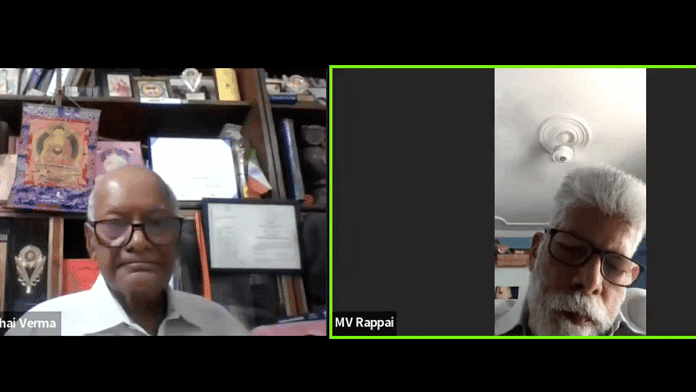New Delhi: The reported construction of a railway line connecting the province of Xinjiang with Tibet, via Aksai Chin, by the People’s Liberation Army (PLA) of China would multiply China’s military capability on India’s northern border, said army veteran, Colonel (Retired) Virendra Sahai Verma Wednesday.
Verma, an honorary fellow at the Institute of Chinese Studies, was speaking at a webinar organised by the New Delhi-based institute.
ThePrint was the media partner of the webinar, titled ‘PLA Plan To Construct a Railway Line Along Aksai-Chin Road Linking Xinjiang with Tibet: Implications for Indian Security.’
“The People’s Republic of China has reportedly made a goal of becoming the number one military and economic power by the middle of this century,” said Verma.
He added that this would require a “review” by the Indian military establishment of a threat posture from the North and North-West. He also highlighted that China is extending its military presence in the Indian Ocean region by acquiring six naval aircraft carriers — “one or more may be deployed in this region”, he added.
Aksai Chin, on the east of Ladakh and a part of the erstwhile state of Jammu and Kashmir, was occupied by China through the 1950s, with the country consolidating its position there in the aftermath of the 1962 Sino-Indian war. The sparsely populated region is of strategic importance for the military — as the recent reported construction of a railway line by China shows.
The line will reportedly run from Shigatse in Tibet, along the northwest borders of Nepal, before cutting across Aksai Chin to reach Hotan in Xinjiang. The first section of the line is expected to be completed by 2025 and the full line is expected to be completed by 2035.
“It is a well-known fact that railways are the best mode for the mass mobilisation of troops, guns and tanks — hence, the importance of the railway line, besides the [Aksai Chin] road that has existed since 1955 or so,” Verma said.
The army veteran also touched upon possible ways to resolve issues with China, and the need to discuss the Dalai Lama’s succession.
Also read: ‘And then there were none’: On G20 eve, US’s Japan envoy says China’s ‘missing’ ministers a mystery
Access to Karakoram Pass of strategic importance
Through the course of his presentation, Verma offered a personal view on the means to resolve issues with China. He argued that the border issue with China in Arunachal Pradesh is “non-negotiable”. However, he posited that it could be possible to negotiate the current northern portion of Aksai Chin occupied by China, where the Chinese have built the Aksai Chin road, in exchange for India reoccupying the southern portion of Aksai Chin.
This, he argued, would give India access to the Karakoram Pass which is of “vital, strategic importance”. Verma explained that the Karakoram Pass at 18,000 feet used to be the main trade route between Ladakh and Xinjiang.
“People in Ladakh still remember the days when they used to cross the Karakoram [Pass] and go to Xinjiang and traders from Xinjiang used to come to Ladakh,” Verma said.
Since 1949, there has been no trade via the Karakoram Pass, which has affected this ancient trade route between the people of the two regions. According to Verma, his proposed border would give India an “elbow room” with regards to the Karakoram Pass.
This proposed border, he argued, could help resolve one of the major border issues with China and may even have a positive effect on resolving the issues of China’s “claims” on Arunachal Pradesh. The second positive from the newly agreed border would be the restoration of livelihoods in Ladakh through the resumption of trade with the Xinjiang province.
The chair of the session, M.V Rappai, a security analyst and honorary fellow at the Institute of Chinese Studies, however, argued that such a bargain could happen only if India was negotiating from a position of strength.
‘Deficiencies in oil hurting China’s ambitions’
Verma said one of the major issues facing China in its ambition to become the number one global military and economic powerhouse is its lack of oil.
“[A] limitation is that oil has to be imported from West Asia and transported through [the] Indian Ocean Region,” he said. While the China-Pakistan Economic Corridor (CPEC) would allow China access to oil from the Arabian Sea, it limits its overall effectiveness as the distance between the West and East of China is large.
Verma explained how India’s domination of the Indian Ocean Region and its air superiority in its northern borders are two major limiting factors for China.
“The high altitude airfields in Tibet limit [the] load and range carrying capabilities of fighter aircraft,” said Verma. In comparison, he highlighted how India’s aircraft and airfields in the northern border areas are low altitude and this allows a full load-carrying capacity of Indian aircraft that could “cover most of China”.
Another important idea Verma highlighted was the necessity of discussing the succession of the Dalai Lama. “The succession issue requires a lot of thinking and discussion with Dharamshala,” he added.
A serious alternative Buddhist leadership is required to continue to favourably influence the people living in India’s borders and Tibet, Verma said.
(Edited by Smriti Sinha)
Also read: Erdoğan pushes back against India-Middle East-Europe corridor — ‘no corridor without Turkey’



